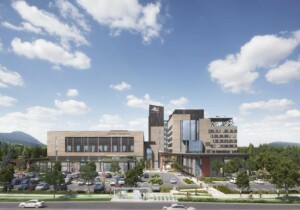There is something surreal in the new exhibition at the Museum of Vancouver (MOV), Your Future Home: Creating the New Vancouver, on view until May 15. It’s not just the museum’s late ’60s architecture by Gerard Hamilton. It’s not the giant crab in a fountain that ushers patrons into a dome-like edifice with a cavernous interior reminiscent of some sci-fi film about “the future.” (George Pal’s The Time Machine springs to mind.)
It’s also not the slightly trippy Brian Eno music, or even the Through the Looking Glass–style mirror (Can You Afford to Be Here by Dialog) that exhales phrases in different languages about what it’s like to live in the city with the highest cost of housing in North America. This mirror returns the civic gaze—and responsibility—to the viewer.
Rather, it’s the whole meta-theater of it: the museum is actually a kind of real estate sales center where patrons are prospective buyers.
“Vancouver is a city in flux, undergoing massive growth and redevelopment,” said Gregory Dreicer, MOV’s director of curatorial and engagement, who worked alongside exhibition designers McFarlane Biggar Architects. “With as many as three homes demolished each day—often to make room for denser living—we are experiencing a watershed moment in the history of the region.”
While talking about the price of real estate has become something of a civic obsession, Dreicer said the aim of the exhibition is “to shift the conversation from real estate to the state of the city.”
Your Future Home opens with a huge wall of photographs of various housing types in the city—from a homeless tent to a mansion to an old railway house—all underlined in red to mimic the current trend in real estate marketing literature. (In Vancouver’s overheated market, homeowners regularly receive such notices of recent sales in their mailboxes.)
The intent here is to focus on the residential typology itself, rather than to fetishize price per square footage, and the wall of homes is an intriguing mosaic of Vancouver housing styles.
Next, patrons are ushered into a mock sales center with a collage of various parts of the city. Faux sales sheets offer statistics about the city itself—as if it were a single property. An adjacent wall, plastered with a huge image of the typical Vancouver city view, is punctuated by various other statistics like
“50% of Vancouverites use private cars, 5% bicycles.” Across from this view, four flat screen monitors offer maps and statistics compiled by planner Andy Yan, illustrating the exhibition’s central themes: housing affordability, residential density, ease of transportation, and quality of public space.
An animated video of Vancouver draws one into city streetscapes. Across from it another aerial view photograph of the city proves revealing: Vancouver’s downtown is a tiny peninsula of density, surrounded by a sea of suburban style housing.
With text noting a projected population increase of 150,000 residents by the year 2040, the question, Where will they all live? hovers (metaphorically) above the idyllic view.
The third section attempts to answer that question while raising many others. While uneven at times, and slightly overwhelming, this part of the exhibition has a curiously Victorian feel about it, with many of the several dozen mini-exhibits mounted on blocks, reading like dioramas reimagined for the 21st century.
One by Erick Villagomez called The Grid is a simple wooden cube with a grid imposed on it, and a kind of viewmaster-cum-pinhole-camera that looks down into a montage of fantastical civic images that aim to encourage a “new social and spatial order.”
The grid is applied to a Vancouver beach, and a dense cluster of high-rises applied to a wealthy waterfront enclave. Nature is overlaid with built environment and new urban models are superimposed on suburban landscapes, offering inventive takes on new ways to inhabit the city.
Another highlight is architect Gregory Henriquez’s Vertical City that plays with the idea of a dramatic shift in scale and Vancouver’s obsession with “the view.” Here, a model for a 2,500-foot-tall highrise is created by upending a 15-block area of the city complete with existing buildings. A large roof top terrace features a “sky garden” and a dizzying view.
Framed by a loop of photos of important civic events and city builders on one end and a film about public space and transportation on the other, neighborhood histories—how Chinatown residents rallied to save their community from a freeway—mingle with imagined futures like a post-global warming transportation network for bicycles.
Architect Oliver Lang offers a dense pyramidal model as an alternative to both low-rise sprawl and highrise living. And architect Javier Campos presents Density in Section as a kind of cri de coeur for greater diversity of built environment in the city, one that mixes residential, commercial, and industrial. Fittingly for a rail against homogeneity and conformity, the model consists of a series of tiny multi-leveled flags bearing images of buildings that form a triangular peak, and read like banners of protest.
Your Future Home is as much a call to arms to save the soul of a place in danger of becoming a resort town for the wealthy, as it is a celebration of the city. The exhibition manages to foil Vancouver’s real estate–fueled fortress mentality of isolation and unaffordability even as it critiques it, simply by engaging patrons and offering both historical insight and potent possibilities.










